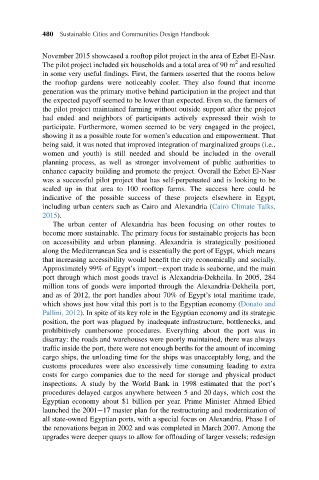Page 511 - Sustainable Cities and Communities Design Handbook
P. 511
480 Sustainable Cities and Communities Design Handbook
November 2015 showcased a rooftop pilot project in the area of Ezbet El-Nasr.
2
The pilot project included six households and a total area of 90 m and resulted
in some very useful findings. First, the farmers asserted that the rooms below
the rooftop gardens were noticeably cooler. They also found that income
generation was the primary motive behind participation in the project and that
the expected payoff seemed to be lower than expected. Even so, the farmers of
the pilot project maintained farming without outside support after the project
had ended and neighbors of participants actively expressed their wish to
participate. Furthermore, women seemed to be very engaged in the project,
showing it as a possible route for women’s education and empowerment. That
being said, it was noted that improved integration of marginalized groups (i.e.,
women and youth) is still needed and should be included in the overall
planning process, as well as stronger involvement of public authorities to
enhance capacity building and promote the project. Overall the Ezbet El-Nasr
was a successful pilot project that has self-perpetuated and is looking to be
scaled up in that area to 100 rooftop farms. The success here could be
indicative of the possible success of these projects elsewhere in Egypt,
including urban centers such as Cairo and Alexandria (Cairo Climate Talks,
2015).
The urban center of Alexandria has been focusing on other routes to
become more sustainable. The primary focus for sustainable projects has been
on accessibility and urban planning. Alexandria is strategically positioned
along the Mediterranean Sea and is essentially the port of Egypt, which means
that increasing accessibility would benefit the city economically and socially.
Approximately 99% of Egypt’s importeexport trade is seaborne, and the main
port through which most goods travel is Alexandria-Dekheila. In 2005, 284
million tons of goods were imported through the Alexandria-Dekheila port,
and as of 2012, the port handles about 70% of Egypt’s total maritime trade,
which shows just how vital this port is to the Egyptian economy (Donato and
Pallini, 2012). In spite of its key role in the Egyptian economy and its strategic
position, the port was plagued by inadequate infrastructure, bottlenecks, and
prohibitively cumbersome procedures. Everything about the port was in
disarray: the roads and warehouses were poorly maintained, there was always
traffic inside the port, there were not enough berths for the amount of incoming
cargo ships, the unloading time for the ships was unacceptably long, and the
customs procedures were also excessively time consuming leading to extra
costs for cargo companies due to the need for storage and physical product
inspections. A study by the World Bank in 1998 estimated that the port’s
procedures delayed cargos anywhere between 5 and 20 days, which cost the
Egyptian economy about $1 billion per year. Prime Minister Ahmed Ebied
launched the 2001e17 master plan for the restructuring and modernization of
all state-owned Egyptian ports, with a special focus on Alexandria. Phase I of
the renovations began in 2002 and was completed in March 2007. Among the
upgrades were deeper quays to allow for offloading of larger vessels; redesign

